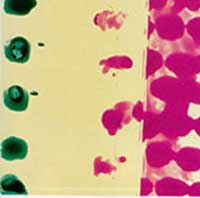 A Colour Box (1935) is under four minutes of primitively animated sound film, a light show in color, painted directly on celluloid, to a snazzy piece of Carribean jazz, "La Belle Creole" by Don Baretto & his Cuban Orchestra. In 2005 the Annency Film Festival brought together a panel of animation experts, who included A Colour Box in their top-ten list of the world's most influential animation.
A Colour Box (1935) is under four minutes of primitively animated sound film, a light show in color, painted directly on celluloid, to a snazzy piece of Carribean jazz, "La Belle Creole" by Don Baretto & his Cuban Orchestra. In 2005 the Annency Film Festival brought together a panel of animation experts, who included A Colour Box in their top-ten list of the world's most influential animation.
At the time such films could obtain financial support & were shown more or less as "advertisements" in theaters, though the primary concession to being an ad rather than a self-supported artwork tended to amount to the sorts of ads one gets on public television & public radio. A Colour Box & other of Lye's little films advertised the post office.
Color films were still uncommon in the 1930s & there was considerable novelty to seeing streaks & shapes & shadows in all colors bouncing around on the screen. The appeal may be less novel today but it still has charm, & the careful manner by which it is all syncronized to excellent music assures Lye's musical shorts lasting entertainment value.
During MTV's music video heyday they should've been inserting stuff like this so young viewers would've known that there are no new ideas! New Zealand's leading avant garde artist Len Lye (1901-1980) made all sorts of art, not just animated films, though it is for these unusual & technically advanced films he is best remembered.
Lye moved from New Zealand to England in 1926 & was immediately active in the modernist movement, befriended by such as Robert Graves, Laura Riding, & Dylan Thomas. Besides films he wrote surreal stories & essays & poetry & moving sculpture, besides being an all-round eccentric.
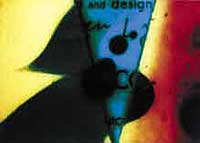 In his visual art he was strongly influenced by Mauri, Oceanic, & African art. Before arriving in England he travelled throughout the Pacific Islands getting to know aboriginal peoples, after having been expelled from New Zealand for living among the Mauri, as officialized national racism was acute at the time. In his visual art he was strongly influenced by Mauri, Oceanic, & African art. Before arriving in England he travelled throughout the Pacific Islands getting to know aboriginal peoples, after having been expelled from New Zealand for living among the Mauri, as officialized national racism was acute at the time.
Several of his films closely resemble A Colour Box sharing much the same purpose & content. Colour Flight (1939) features Red Nichols & his Five Pennies performing "Honolulu Blues" to another of Lye's painted-on-celluloid "Gasparcolour" films of flashing & dashing colors & shapes & patterns & lines, nearly four colorful minutes syncronized to a wonderful musical performance. It ends as an advedrtisement for Imperial Airways who funded the little film.
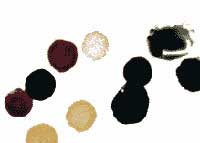 Swinging the Lambeth Walk (1939) revisits the same techniques, another experiment in motion of animated color, this time to western swing jazz. Much of it looks like finger painting & it's the music that carries it as a delightful three & a half minutes. The "Lambeth Walk" was a fad dance of the year, now of course long forgotten. Swinging the Lambeth Walk (1939) revisits the same techniques, another experiment in motion of animated color, this time to western swing jazz. Much of it looks like finger painting & it's the music that carries it as a delightful three & a half minutes. The "Lambeth Walk" was a fad dance of the year, now of course long forgotten.
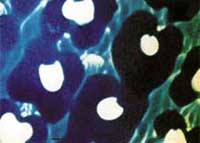 Kaleidoscope (1935) uses a lot of stencilling directly onto filmstock. This is again moving colors, syncronized to the music of Don Baretto & his Cuban Orchestra. The stencils include cigarettes because the film was sponsored by the Imperial Tobacco Company. For the 1935 premier, Lye hand-cut tiny cigarette shapes out of the 35 mm filmstock so that the brightest possible light would project onto the screen. Kaleidoscope (1935) uses a lot of stencilling directly onto filmstock. This is again moving colors, syncronized to the music of Don Baretto & his Cuban Orchestra. The stencils include cigarettes because the film was sponsored by the Imperial Tobacco Company. For the 1935 premier, Lye hand-cut tiny cigarette shapes out of the 35 mm filmstock so that the brightest possible light would project onto the screen.
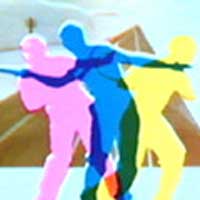 Rainbow Dance (1936) has an increased appeal by right of incorporating a human subject. It clocks in at just under four minutes, featuring the dancing & sportsmanship of Rupert Doone turned into surreal animation, partly an early example of rotoscoping. Rainbow Dance (1936) has an increased appeal by right of incorporating a human subject. It clocks in at just under four minutes, featuring the dancing & sportsmanship of Rupert Doone turned into surreal animation, partly an early example of rotoscoping.
The Carribean jazz to which the film is syncronized is by Rico's Creole Band. This is an appealing little experiment in motion, & an after a viewing several of these we films, it becomes obvious that Len Lye was a major influence on Walt Disney for Fantasia.
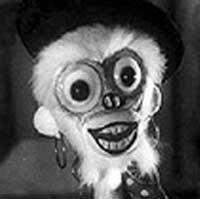 A personal favorite of mine is The Peanut Vendor (1933) which Lye initially blandly titled Experimental Animation. Set in the street of a tropical city, a Latin American peanut vendor's song is performed by the happiest & weirdest damned spider monkey puppet. It is black & white stop-motion animated work of genius. A personal favorite of mine is The Peanut Vendor (1933) which Lye initially blandly titled Experimental Animation. Set in the street of a tropical city, a Latin American peanut vendor's song is performed by the happiest & weirdest damned spider monkey puppet. It is black & white stop-motion animated work of genius.
To get the monkey's rumba moves correct, Len's wife Jane modeled for him, making it easier to calculate each movement of the puppet's many articulations.
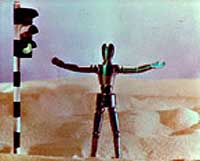 The music is once again by Red Nichols & his Five Pennies. Lye had hoped this little film would gain him funding or business partners for a series of puppet toons, but no backers were forthcoming. The music is once again by Red Nichols & his Five Pennies. Lye had hoped this little film would gain him funding or business partners for a series of puppet toons, but no backers were forthcoming.
He would revisit stop motion puppetry with Birth of a Robot (1936) animating the Shell Oil Company robot trademark because sponsored by Shell Oil.
The robot's dance is syncrynized to selections of Gustav Holst's "The Planets." Visually one of his most accessible & easily liked experiments, Birth of a Robot probably remains his best known film, though i much prefer the weird peanut vendor puppet.
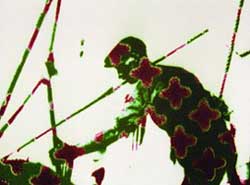 For Trade Tattoo (1937) Lye took a totally different route. Starting with found documentary footage, this was edited & altered with additions of stenciled shapes & words until it looks almost entirely animated, syncronized to the tropical swing music of the Leucuona Band, made on technicolor film. It's a miniature masterpiece at about five & a half minutes. For Trade Tattoo (1937) Lye took a totally different route. Starting with found documentary footage, this was edited & altered with additions of stenciled shapes & words until it looks almost entirely animated, syncronized to the tropical swing music of the Leucuona Band, made on technicolor film. It's a miniature masterpiece at about five & a half minutes.
In 1944 he moved to New York & continued making short films & kinetic sculpture. Rhythm (1957) features what sounds like snazzy jazz drumming but it is actually authentic African drumming, syncronized for a minute to a montage of found footage of automobile manufacturing plant in operation.
Free Radicals (1958) in stark black & white resembles scratchboard or chalkboard work, this time putting images to African drumming & singing by the Bagirmi tribe. A march of lines & squiggles & zigzags. Nothing specific ever surfaces out of the white scribbles except the titles at the beginning, but it plays with the psyche in interestng ways as though we might be able to find something of the savannah in there if we look long enough. It is very primitive & appealing, but Len rethought the film for some reason & shortened it by about one minute, to four minutes, in 1979.
copyright © by Paghat the Ratgirl
|
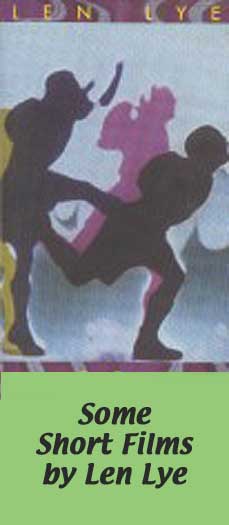

 In his visual art he was strongly influenced by Mauri, Oceanic, & African art. Before arriving in England he travelled throughout the Pacific Islands getting to know aboriginal peoples, after having been expelled from New Zealand for living among the Mauri, as officialized national racism was acute at the time.
In his visual art he was strongly influenced by Mauri, Oceanic, & African art. Before arriving in England he travelled throughout the Pacific Islands getting to know aboriginal peoples, after having been expelled from New Zealand for living among the Mauri, as officialized national racism was acute at the time. Swinging the Lambeth Walk (1939) revisits the same techniques, another experiment in motion of animated color, this time to western swing jazz. Much of it looks like finger painting & it's the music that carries it as a delightful three & a half minutes. The "Lambeth Walk" was a fad dance of the year, now of course long forgotten.
Swinging the Lambeth Walk (1939) revisits the same techniques, another experiment in motion of animated color, this time to western swing jazz. Much of it looks like finger painting & it's the music that carries it as a delightful three & a half minutes. The "Lambeth Walk" was a fad dance of the year, now of course long forgotten. Kaleidoscope (1935) uses a lot of stencilling directly onto filmstock. This is again moving colors, syncronized to the music of Don Baretto & his Cuban Orchestra. The stencils include cigarettes because the film was sponsored by the Imperial Tobacco Company. For the 1935 premier, Lye hand-cut tiny cigarette shapes out of the 35 mm filmstock so that the brightest possible light would project onto the screen.
Kaleidoscope (1935) uses a lot of stencilling directly onto filmstock. This is again moving colors, syncronized to the music of Don Baretto & his Cuban Orchestra. The stencils include cigarettes because the film was sponsored by the Imperial Tobacco Company. For the 1935 premier, Lye hand-cut tiny cigarette shapes out of the 35 mm filmstock so that the brightest possible light would project onto the screen. Rainbow Dance (1936) has an increased appeal by right of incorporating a human subject. It clocks in at just under four minutes, featuring the dancing & sportsmanship of Rupert Doone turned into surreal animation, partly an early example of rotoscoping.
Rainbow Dance (1936) has an increased appeal by right of incorporating a human subject. It clocks in at just under four minutes, featuring the dancing & sportsmanship of Rupert Doone turned into surreal animation, partly an early example of rotoscoping.
 The music is once again by Red Nichols & his Five Pennies. Lye had hoped this little film would gain him funding or business partners for a series of puppet toons, but no backers were forthcoming.
The music is once again by Red Nichols & his Five Pennies. Lye had hoped this little film would gain him funding or business partners for a series of puppet toons, but no backers were forthcoming. For Trade Tattoo (1937) Lye took a totally different route. Starting with found documentary footage, this was edited & altered with additions of stenciled shapes & words until it looks almost entirely animated, syncronized to the tropical swing music of the Leucuona Band, made on technicolor film. It's a miniature masterpiece at about five & a half minutes.
For Trade Tattoo (1937) Lye took a totally different route. Starting with found documentary footage, this was edited & altered with additions of stenciled shapes & words until it looks almost entirely animated, syncronized to the tropical swing music of the Leucuona Band, made on technicolor film. It's a miniature masterpiece at about five & a half minutes.